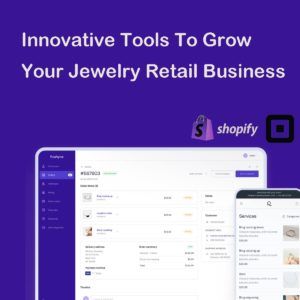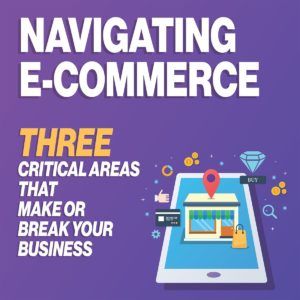How to Design Your Website Like a New Store
Do you make more than 10% of your total sales online? Have you hit 25% yet? Or do you still see your website as a marketing channel rather than sales?
Many retailers know what it takes to make a brick-and-mortar store successful. But many jewelers also do not apply those same principles to their website in order to increase sales.
Jewelers should be investing in their website like they would in a new store. Gone are the days of thinking of your website as merely a brochure or catalogue. Your website is another cashier available to customers whenever they want it.
The topic of digital assets is unpacked in recent Plumb Club podcasts where member companies share actionable information jewelers can implement now in their business strategies to be more successful.
Here are some of the highlights:
Today’s consumers want to shop local and online. Shopify research reveals that consumers want to support entrepreneurship, want unique products, and want the specialized service a local business can provide. “That means local consumers who are not yet your customers are ready to buy from you if you have unique products and good service,” highlights jewelry industry consultant Cheryl Kremkow in a Plumb Club podcast, sponsored by Benchmark. Every age group shops more online than they did in 2019. Consumers are purchasing more online because that’s where they spend most of their time, seven hours and 50 minutes a day, according to 2020 data from eMarketer.
To continue to grow your sales in the future it’s essential to have a successful online bridal business. “Today, one in five engagement rings and one in three wedding bands are purchased online and that percentage increases every year,” shares Kremkow. She cites that two out of three consumers, ages 18-34, a jeweler’s target bridal customers, are spending more money buying online than they did before the pandemic, according to Shopify data. At least 20% of all jewelry sales are expected to occur online by 2025. In fact, 25% of all retail sales are expected to happen online in the next three years.
Online functionality has come a long way in the last 20 years. If your business website uses a system that pre-dates 2007, you’re better off using smoke signals, says Sean McCormick, director of social media for Novell Enterprises, a division of Continental. He unpacked digital strategies in a Plumb Club podcast with Novell’s in-house photographer, Sarah Siegel. If you haven’t updated your web site in the last five years, you’re probably missing opportunity connecting with consumers to convert digital sales leads into revenue,” he says. In 2022 73% of ecommerce sales are expected to happen on a smart phone and websites must be compatible, underscores Carolina Almanzar, senior sales representative with iStar Jewelry, who teamed up with company vice president Karl Schmid in a Plumb Club podcast on retailing to today’s customers. Key to attracting and keeping customers on your website is that it loads quickly and no matter the device viewed on the right presentation for that format appears.
Consider your website as more of a digital salesperson. Set goals and reevaluate progress every six-months like you would with sales staff, McCormick says. Talk to your customers and find out how they shop online, and address issues on your site that impede the process and shopping experience. Thinking of your website as a store or digital salesperson also means you need to staff your web site, says Kremkow. “You can’t do a good job selling online without having people behind the web pages. If you don’t have someone on call to respond immediately to customer questions, you’re not providing the good service consumers expect. She advocates jewelers add Live Chat to their website if they haven’t already. “Speaking to a real person builds trust and communicates you’re a local jeweler who’s part of the community. A recent study found 79% of businesses saw an increase in customer loyalty, sales and revenue when Live Chat was implemented, as it reinforces good service.”
 Having your inventory online and all your sales channels connected is foundational to just staying relevant says Chris Awad, head of marketing, and Jason Yakubovich, director of operations for MJJ Brilliant in a Plumb Club podcast dishing about innovative tools to grow your jewelry retail business. There are many ecommerce options that have built-out websites retailers can use like Shopify, Wicks and SquareSpace, with some easier than others for retailers to upload their own content. Awad considers Shopify the easiest to get ecommerce up and running quickly and integrated with all of your social media platforms and other applications needed to run your business. In addition to a fast, easy-to-use website, consumers want 30-day hassle free returns and free shipping when they buy online.
Having your inventory online and all your sales channels connected is foundational to just staying relevant says Chris Awad, head of marketing, and Jason Yakubovich, director of operations for MJJ Brilliant in a Plumb Club podcast dishing about innovative tools to grow your jewelry retail business. There are many ecommerce options that have built-out websites retailers can use like Shopify, Wicks and SquareSpace, with some easier than others for retailers to upload their own content. Awad considers Shopify the easiest to get ecommerce up and running quickly and integrated with all of your social media platforms and other applications needed to run your business. In addition to a fast, easy-to-use website, consumers want 30-day hassle free returns and free shipping when they buy online.
“In 2019 63% of abandoned online carts were due to unexpected shipping costs. You could loss a $1,000 sale over $20 in shipping,” alerts Kremkow. “Make it easy to buy online and return at your store or get service in person. Customers expect all of your sales channels to be connected.”
Providing a consistent shopping experience online starts with making sure your web store looks and feels like your brick-and-mortar store. “It should match your store’s unique personality and the way it is expressed through all of your customer touch points,” Kremkow advises. “Fonts, images and design for your online store should reflect your unique personality.” To invest in making your website feel like a store, images and content that inspire and engage are key. Like your brick-and-mortar store, your website has to be constantly tweaked to serve your customers well. Pay attention to the same things in your online store. Which products are looked at the most? What are customers asking for in chat or search? Which pages hold their interest, which don’t? Can they find what they’re looking for easily? Optimize your owned assets and align your customer in-store experience with that online, presenting a consistent message across communication channels, Awad advocates.
 High-quality images that upload quickly increase sales conversions. Before customers even arrive at your website or social media, they often search for something as generic as jewelry and the name of the town they are in. Customers who see an image show up in relation to a business in search results are 60% more likely to contact that business, finds MDG Advertising research, cites Kye Ehrlich, head of photography and graphic arts atThe Marathon Company, in a Plumb Club podcast. Moreover, 40% of consumers left websites if the images did not load properly. The likelihood of selling a product rises by 63% when you have a basic image, if nothing else changes, as compared to a product with no image at all, according to Ebay research. Sales double if a high-quality image is included, while conversion rates decline if a low-quality image is used, revealing consumers value quality images when making purchase decisions. In fact, one of the top reasons people return an item is that it wasn’t accurately depicted. Ehrlich encourages retailers to ask their suppliers for visual collateral.
High-quality images that upload quickly increase sales conversions. Before customers even arrive at your website or social media, they often search for something as generic as jewelry and the name of the town they are in. Customers who see an image show up in relation to a business in search results are 60% more likely to contact that business, finds MDG Advertising research, cites Kye Ehrlich, head of photography and graphic arts atThe Marathon Company, in a Plumb Club podcast. Moreover, 40% of consumers left websites if the images did not load properly. The likelihood of selling a product rises by 63% when you have a basic image, if nothing else changes, as compared to a product with no image at all, according to Ebay research. Sales double if a high-quality image is included, while conversion rates decline if a low-quality image is used, revealing consumers value quality images when making purchase decisions. In fact, one of the top reasons people return an item is that it wasn’t accurately depicted. Ehrlich encourages retailers to ask their suppliers for visual collateral.
Keywords in clear concise language capture consumer attention. In addition to quality visual media, quality written content gets customers excited about products, says Anthony Marotta, vice president of marketing for Prime Art Jewelry in a Plumb Club podcast discussing ecommerce strategies with President Dillion Chen. “While you want to include certain keywords that can be more likely found by search engines, the challenge is to write listings in clear, concise, straightforward language. Good copy is easy to understand. Highlight the benefits of the product, what it is going to do for the buyer — enhance their fashionability, connect with a lifestyle or emotion, or aspirational.” Chen says the more general your terms are the greater the traffic but lower the conversion. The more specific you get, the less traffic but the higher the conversion.
Social media platforms allow jewelers to connect with customers on more intimate level. “You can maximize the relationship you have with current customers and new, by understanding how social media is used in today’s marketplace,” McCormick says. “We use Twitter as the announcement to the party or for breaking news. Facebook is the party. You can act on a more intimate level while developing your relationship like you would in your store.” Instagram, SnapChat and Pinterest are where the majority of people willing to shop on social media go to shop. These platforms are the most powerful tools to sell jewelry online to new customers, he cites. YouTube will not generate revenue but would be entertainment for customers. With social media you can direct web traffic to different places, says Marotta. He advocates creating a promotional calendar for the year to be coordinated across all touchpoints.
Integrating shopping calls to action in social media posts and ads also help to engage potential customers. Optimize your digital ad spend for online sales instead of encouraging in-store traffic advises Kremkow. She notes that it’s important to attract shoppers who know what they want, but not yet where to get it. “That means creating landing pages, pages designed to attract shoppers in your area who are searching for specific products. “Target specific keyword phrases with relevant content and product. Link to these pages from Google search ads.” Landing pages that are designed to show shoppers exactly what they’re looking for provide better online service. “Over time these landing pages will also attract organic traffic,” she says. “This saves you marketing dollars.”
 Email marketing is probably considered to be the most profitable aspect of an ecommerce strategy says Chen. The hard work is in acquiring the emails — which might occur when a visitor first enters the website; makes a purchase online, signs up for promotions, offers and newsletters on social media; and in-store for sales and service information. Email marketing is a way for a business to put an offer in front of their customers basically for free, with the chance to make a sale, he underscores. While you shouldn’t bombard your customers with emails, you should come before them with some sort of value proposition. Jewelers should be getting news that excites them — like a discount, free gift, local social event, coveted product launch, items that are exclusive or limited edition. Email programs can help you manage your customer list.
Email marketing is probably considered to be the most profitable aspect of an ecommerce strategy says Chen. The hard work is in acquiring the emails — which might occur when a visitor first enters the website; makes a purchase online, signs up for promotions, offers and newsletters on social media; and in-store for sales and service information. Email marketing is a way for a business to put an offer in front of their customers basically for free, with the chance to make a sale, he underscores. While you shouldn’t bombard your customers with emails, you should come before them with some sort of value proposition. Jewelers should be getting news that excites them — like a discount, free gift, local social event, coveted product launch, items that are exclusive or limited edition. Email programs can help you manage your customer list.


